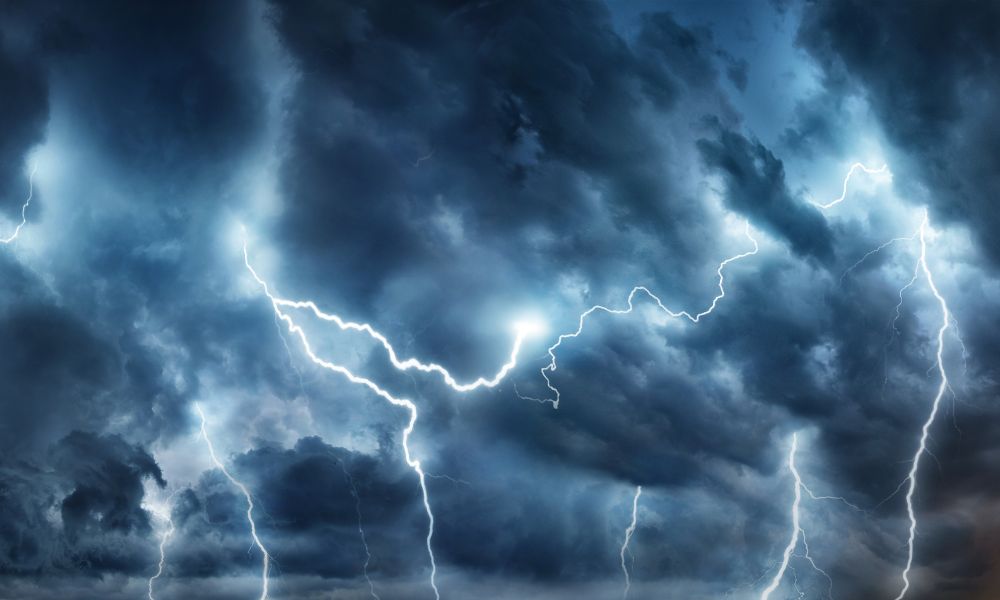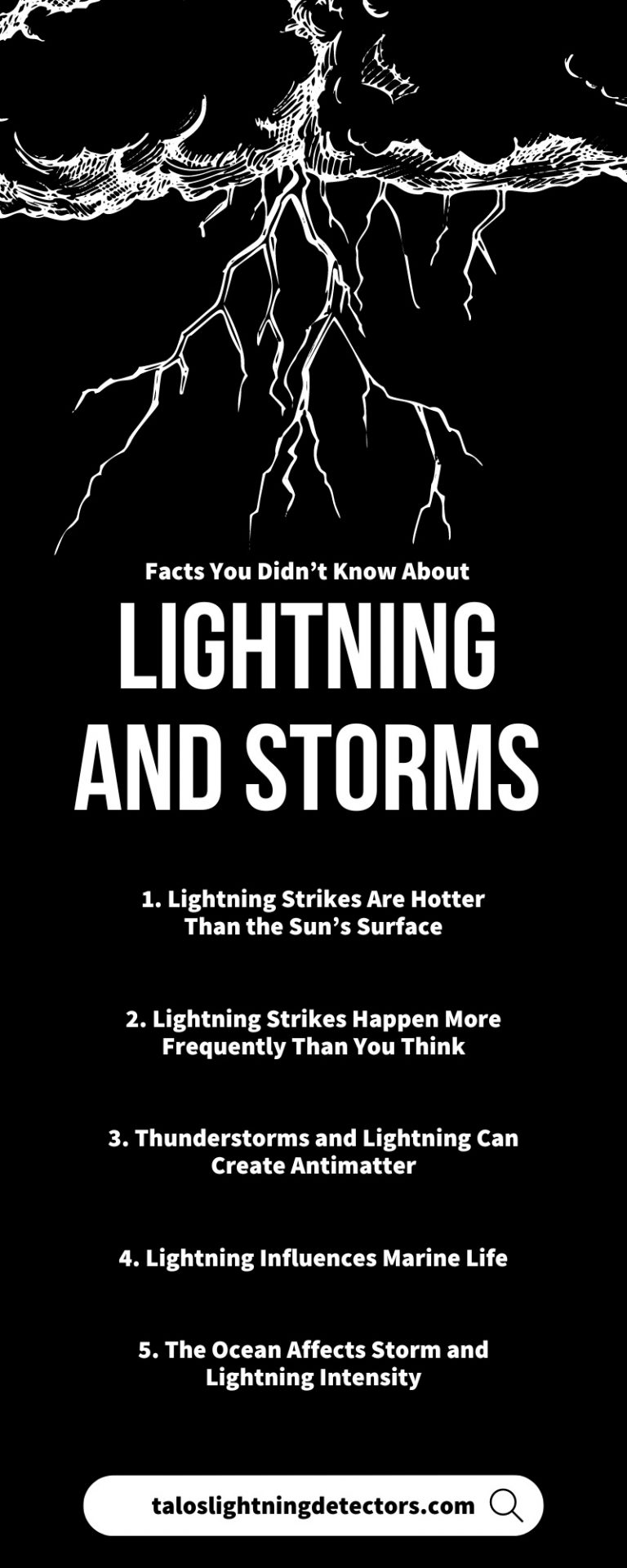8 Facts You Didn’t Know About Lightning and Storms

Lightning and storms have always inspired awe and fear. The illumination and shape of lightning bolts exude eerie beauty. The moody darkness and rhythmic rainfall of storms can be soothing for many people. Both of these phenomena show the beauty and power of nature. However, lightning and storms can also take turns for the worst, causing injuries and damage to anyone and anything nearby.
Uncover the expanse of these powerful natural wonders by exploring eight facts you didn’t know about lightning and storms.
1. Lightning Strikes Are Hotter Than the Sun’s Surface
The sun is a star, and it emits destructive heat. Despite being about 93 million miles away from the sun, we can feel the sun’s heat from Earth. However, the temperature of lightning surpasses that of the sun’s surface, reaching a staggering 30,000 Kelvin (53,540 degrees Fahrenheit), compared to the sun’s temperature of 5,500 Kelvin (9,932 degrees Fahrenheit)! This extreme heat arises from a thunderstorm’s rapid, violent movement of electrical charges. These charges collide and generate enough energy to ignite the surrounding air molecules, creating a plasma—superheated matter—channel that we perceive as a bright flash of light. The heat also contributes to thunder, which is the sound of lightning. The rapid heating and cooling of the air creates a shock wave.
2. Lightning Strikes Happen More Frequently Than You Think
Earth experiences an incredible number of lightning strikes every day. The National Weather Service estimates 100 lightning flashes per second occur worldwide, equaling 8 million times per day globally! Interestingly, these strikes are not evenly distributed across the earth. Certain regions receive a disproportionately high number of strikes compared to others. For example, Florida is the “Lightning Capital” of the United States. Fun Fact: The TALOS lightning detector was designed and developed in Florida!
The state’s unique geographical location, being a peninsula surrounded by warm waters, contributes to its high frequency of lightning strikes. Warm, moist air from the Gulf of Mexico and the Atlantic Ocean converges over Florida, forming thunderclouds with intense electrical charges.
3. Thunderstorms and Lightning Can Create Antimatter
Here’s a phenomenon that seems to come right out of a science fiction novel: NASA scientists have discovered that thunderstorms can produce antimatter. During a storm, the interaction of lightning with the atmosphere and the creation of a strong electric field drives an upward avalanche of electrons. These high-energy electrons can reach speeds nearly as fast as the speed of light and give off gamma-ray bursts when deflected by atoms and molecules in the atmosphere. Some of these gamma rays transform into a pair of particles, an electron and a positron, which is the antimatter counterpart of an electron.
This discovery not only affirms the incredible power of thunderstorms but also provides scientists with a natural particle accelerator. The interplay of energy, matter, and antimatter in stormy skies continues to drive particle physics research.
4. Lightning Influences Marine Life
Lightning strikes can affect more than people, buildings, and vehicles. Many marine ecosystems face destruction in the wake of a lightning strike. The heat and shock waves from lightning can kill fish and other marine organisms. Lightning also creates nitrate, a crucial nutrient for phytoplankton and a stimulant for algae blooms. When algae die and decompose on the surface of the water, oxygen levels in the water deplete, leading to the death of aquatic animals like fish and turtles.
5. The Ocean Affects Storm and Lightning Intensity
The temperature of the surface water in oceans plays a significant role in determining the intensity of a storm. Warm waters are critical for the formation of tropical storms and hurricanes. These warm conditions provide the energy for storms, resulting in more intense and frequent thunderstorms and lightning activity.
The salinity and temperature of the sea’s surface can also influence electrical conductivity and lightning intensity. In other words, higher conductivity facilitates more powerful lightning strikes.
6. Lightning Can Strike Without Rain
Lightning without rain is often referred to as a “bolt from the blue.” It occurs when a lightning bolt travels horizontally away from the thunderstorm and strikes the ground outside of the area where it’s raining. These bolts can strike as far as 25 miles away from the storm in areas where the sky might appear clear. They are dangerous because they may catch people off guard, leading to the proverbial advice, “If you can hear thunder, you’re close enough to be struck by lightning.” Bolts from the blue remind us of the far-reaching power and unpredictability of lightning.
7. Lightning Finds the Path of Least Resistance
Since lightning is a form of electrical energy, it always seeks the easiest path to the ground or a positively charged surface. When a storm cloud discharges electricity, it creates an invisible path of ionized air, descending toward the ground in steps via a path with the least electrical resistance.
Typically, paths of least resistance include an object that stands high in the air, like a tree or a tower. However, the tallest object in an area doesn’t always get struck. Other factors, such as the shape and conductivity of objects or even the presence of moisture, can influence the path of least resistance that the bolt takes. The vast expanse of the ocean is a common target for lightning strikes due to the conductivity of salt water and the presence of charged particles in the atmosphere above the ocean’s surface, providing minimal resistance.
8. The Ocean Is the Riskiest Place To Be During Storms
The combination of high winds, lightning, and unpredictable waves can create an extremely hazardous environment. During a storm, the ocean is a conductor, increasing the likelihood of lightning strikes and immediate, widespread electrocution.
The ocean can be one of the riskiest places to be during a storm with lightning threats, making marine lightning detectors essential proponents to add to any watercraft, from kayaks to motorboats. With a lightning detector, boaters can remain aware of their surroundings and promptly return to shore at the first sign of danger.
Lightning and storms are more than just nature’s light show. They interact with the world in many ways. Understanding these facts you didn’t know about lightning and storms highlights the expansive power and danger of storms and lightning. With lightning detection technology, you can keep an eye out for lightning and take cover to marvel at these natural phenomena in safety.

Request a Quote
"*" indicates required fields
At TALOS, Engineering Drives Best-in-Class Quality
Our mission is to provide families with quality products that promote safety and awareness while enjoying leisure activities together. Our patent pending products feature the same technology used in expensive weather stations, but at a fraction of the price.
SHOP NOW
Don’t just take our
word for it.
At TALOS®️, we're developing that technology into new innovative concepts designed for enhancing consumer lifestyles.